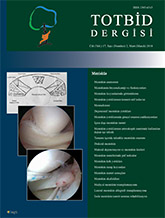
Lateral meniscus has more varieties regarding to size, thickness, shape and mobility, compared to the medial meniscus. The most common variation of the lateral meniscus is discoid meniscus. Discoid meniscus is a congenital variant that typically involves abnormal morphology of the knee joint and potential instability of the lateral meniscus. Discoid meniscus is thicker than usual, and the coverage rate on the tibia is increased. Discoid menisci are prone to tears secondary to increased thickness, poor tissue quality, and instability. Many stable lateral meniscus variants are asymptomatic and are found incidentally. Symptomatic patients often have `clunk` sound with knee flexion especially during childhood and adolescence; pain, decreased range of motion, tenderness on the joint line, foreign body sensation in the knee joint, quadriceps muscle atrophy and joint effusion. Physical examination is particularly sensitive if it is consistent with intraarticular pathology. MRI is used for confirming the diagnosis and planning treatment. Since the discoid meniscus was first described, many classification systems have been proposed, according to clinical, radiological and arthroscopic findings. Many of these classifications are descriptive, and do not give much information about treatment. An ideal treatment is not yet known. Treatment options consist of observation, saucerization of the meniscus, partial meniscectomy, total meniscectomy, and peripheral repair for unstable lesions. Arthroscopic treatment is indicated when non-surgical treatment is unsuccessful. Historically, total meniscectomy has relieved symptoms suc-cessfully, but has poor results with degenerative changes in the knee joint. For this reason, meniscus should be protected as much as possible, saucerization and if necessary repair is the preferred treatment option. Long-term follow-up studies are needed to determine outcomes.